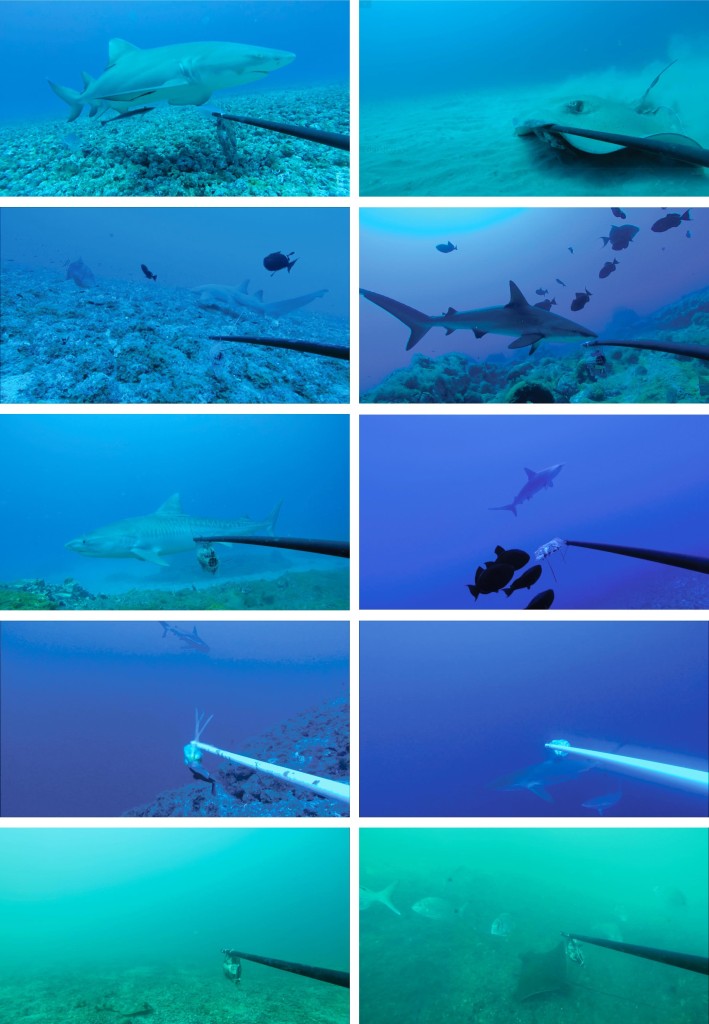Protected areas and fisheries management key to survival
Versão em português abaixo
Overfishing is driving reef sharks toward extinction, according to a new study published this week in Science.
The five main shark species that live on coral reefs — grey reef, blacktip reef, whitetip reef, nurse and Caribbean reef sharks — have declined globally by an average of 63 percent, according to the scientists of Global FinPrint, a five-year international study supported by the Paul G. Allen Family Foundation.
“These are some of the best estimates of population decline of widespread shark species because of the very large number of reefs and countries sampled,” according to Colin Simpfendorfer, lead author of the study and adjunct professor of Marine and Aquaculture Science at James Cook University in Australia. “This tells us the problem for sharks on coral reefs is far worse and more widespread than anyone thought.”

Results from this latest research, which includes 22,000 hours of video footage from baited underwater video stations across 391 reefs in 67 nations and territories, indicate widespread overfishing is the main culprit driving reef sharks toward extinction (Figure 1).
Sharks and rays are common in coral reef ecosystems, but as reefs are more heavily fished, they have become stripped of both shark and ray species or stripped of just shark species, leaving the ecosystem dominated by rays. The loss of sharks could have an impact on the overall health and function of the coral reef ecosystem.
“While overfishing and poor governance are associated with the absence of these species, they are still common in Marine Protected Areas (MPAs) and places where shark fishing was banned or highly regulated,” said Demian Chapman, lead scientist of Global FinPrint and director of the Sharks and Rays Conservation Program at Mote Marine Laboratory. “Reef sharks can be important for human livelihoods through dive tourism and if fished carefully. An investment in reef shark conservation can therefore be good for people, too”.

Early results from this study were previously used to update the status of four of these species to more threatened categories on the International Union for the Conservation of Natures (IUCN) Red List. They were also presented during the most recent Conference of the Parties of the Convention on the International Trade in Endangered Species of Wild Fauna and Flora (CITES), helping world governments to make the groundbreaking decision to better regulate trade in these and more than 50 additional species of sharks.
“This means no trade should come from nations where the take of the species will threaten its survival,” Simpfendorfer said. “This study can be used to help identify those nations where such catches would be detrimental. We need to act now to stop the widespread extinction of shark species in many parts of the world.”
More than 150 researchers from more than 120 institutions across the world contributed to the research.
Check it out in our Published papers!
Os tubarões de recife correm um risco de extinção muito maior do que se pensava
Áreas protegidas e gerenciamento de pesca são fundamentais para a sobrevivência
A revista Science publicou em 15 de junho de 2023 um estudo sobre o estado populacional (Figura 1) dos elasmobrânquios (tubarões e raias) nos recifes tropicais ao redor do mundo. Resultado da cooperação de 153 pesquisadores, o estudo conta com a participação de sete brasileiros de diversas universidades: UFES, UFBA, UFF, UFCE, UFRN e USP. A UFES teve papel relevante na pesquisa graças à atuação do Prof. Jean Joyeux do Departamento de Oceanografia, do Dr. Caio Pimentel, oceanógrafo e doutor em Oceanografia Ambiental (ambos cursos da UFES), e do Dr. Hudson Pinheiro, biólogo (UFES) e doutor em Ecologia e Evolução.
O estudo revela que a sobrepesca está levando à extinção os tubarões recifais, causando drástica diminuição na diversidade de elasmobrânquios. Em particular, uma análise aprofundada com as cinco espécies mais comuns de tubarões revelou declínios populacionais de 60% a 73% na abundância dos indivíduos e que essas espécies não foram detectadas em 34% a 47% dos recifes estudados. À medida que os recifes se tornam mais empobrecidos em tubarões, as raias se tornam dominantes nestes ambientes. Tubarões recifais essencialmente persistem em nações ricas e/ou com uma governança forte, e também em áreas altamente protegidas. Opostamente, pobreza, governança fraca e falta de gestão ambiental estão associadas a recifes dominados por raias. A perda de funções ecológicas e de serviços ecossistêmicos certamente causarão grandes impactos nas comunidades humanas, assim como nos ecossistemas recifais.
Umas das inovações do estudo é a utilização de sistemas de filmagens subaquáticas com iscas de atração (chamados de “BRUVs”, o acrônimo em inglês), uma técnica não invasiva, não destrutiva e ambientalmente sustentável (Figura 2). As principais vantagens do método são a ausência de interferência de mergulhadores ou robôs, a longa duração e a quantidade de amostras, a grande profundidade e os habitats amostráveis, e a não captura dos organismos. Além disso, as amostras (os vídeos) podem ser reanalisadas para verificação ou ampliação do escopo da pesquisa. A UFES, via os laboratórios de Ictiologia e de Ecologia Bêntica (Prof. Ângelo Bernardino) do Departamento de Oceanografia, e suas universidades parceiras têm investido recursos humanos e financeiros significantes em pesquisas no Brasil. Os resultados do grupo são em completo acordo com a pesquisa ora publicada. Assim, tubarões recifais estão ausentes das (não foram registrados nas) amostras coletadas nas regiões da REVIS/APA Costa das Algas, Santa Cruz/ES, de Vila Velha e APA de Setiba, Guarapari/ES e da RESEX de Arraial do Cabo/RJ. Opostamente, eles estão presentes, em diferentes quantidades e espécies, em áreas mais protegidas/conservadas, mais fiscalizadas e mais distantes, como o Banco dos Abrolhos, a Ilha da Trindade e nos arquipélagos de Fernando de Noronha e de São Pedro e São Paulo.
No Espírito Santo, as pesquisas foram financiadas pelos Programas Ecológicos de Longa Duração do CNPq (PELD-HCES e PELD-ILOC, respetivamente coordenados pelos Profs. A. Bernardino da UFES e C.E.L. Ferreira da UFF). O principal financiador do estudo publicado hoje é a Paul G Allen Family Foundation.
O artigo Widespread diversity deficits of coral reef sharks and rays, por Simpfendorfer e colaboradores, pode ser encontrado aqui:

